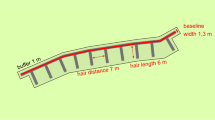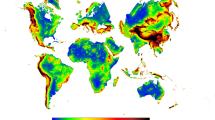Abstract
Digital terrain modeling is widely used in geological studies. In some cases, orthogonal and diagonal linear patterns appear on maps of local topographic variables. These patterns may be both portrayals of geological structures and artefacts. Some researchers speculated that possible anisotropy of operators of local topographic variables might be a cause of these artefacts. Using a principle for testing derivative operators in image processing, we gave proof to isotropy (rotation invariability) of operators of a majority of local topographic attributes of the complete system of curvatures (i.e., slope gradient, horizontal curvature, vertical curvature, mean curvature, Gaussian curvature, accumulation curvature, ring curvature, unsphericity curvature, difference curvature, minimum curvature, maximum curvature, horizontal excess curvature, and vertical excess curvature). Rotating an elevation function about z-axis and then applying these operators cannot lead to variations in both values of the topographic variables and patterns in their maps, comparing with results of applying these operators to an unrotated elevation function. This demonstrates that linear artefacts with preferable directions in maps of the topographic attributes specified cannot be caused by intrinsic properties of their operators. Other possible sources for false linear patterns in maps of topographic variables are briefly discussed: (a) errors in the compilation of digital elevation models (DEMs), (b) grid geometry of digital terrain models (DTMs), (c) errors in DEM interpolation, (d) imperfection of algorithms for DTM derivation, and (e) aliasing errors.
Similar content being viewed by others
References
Belonin, M. D., and Zhukov, I. M., 1968, Geometrical properties of surfaces of the Alexeevskoye uplift, the Kuibyshev Region, in Romanova, M. A., ed., Problems of mathematical geology: Nauka, Leningrad, p. 194–207 (in Russian).
Brown, D. G., and Bara, T. J., 1994, Recognition and reduction of systematic error in elevation and derivative surfaces from 7.5-minute DEMs: Photogramm. Eng. Remote Sens., v. 60, no. 2, p. 189–194.
Chorowicz, J., Kim, J., Manoussis, S., Rudant, J., Foin, P., and Veillet, I., 1989, A new technique for recognition of geological and geomorphological patterns in digital terrain models: Remote Sens. Environ., v. 29, no. 3, p. 229–239.
Chorowicz, J., Dhont, D., and Gündoğdu, N., 1999, Neotectonics in the eastern North Anatolian fault region (Turkey) advocates crustal extension: Mapping from SAR ERS imagery and digital elevation model: J. Struct. Geol., v. 21, no. 5, p. 511–532.
Courant, R., and John, F., 1974, Introduction to calculus and analysis, Vol. 2: Wiley, New York, 954 p.
Declercq, F. A. N., 1996, Interpolation methods for scattered sample data: Accuracy, spatial patterns, processing time: Cartogr. Geogr. Inform. Syst., v. 23, no. 3, p. 128–144.
Douglas, R. J. W., 1974, Tectonics, in Fremlin, G., ed., The national atlas of Canada, 4th rev. edn.: Department of Energy, Mines and Resources and Information Canada, Ottawa, p. 29–30.
Fikhtengolts, G. M., 1966, A course in differential and integral calculus, 6th edn., Vol. 1: Nauka, Moscow, 607 p. (in Russian).
Florinsky, I. V., 1993, Analysis of digital elevation models for recognition of linear structures of the land surface: Unpublished Ph.D. Thesis, Institute of Soil Science and Photosynthesis, Russian Academy of Sciences, Pushchino, 133 p. (in Russian).
Florinsky, I. V., 1996, Quantitative topographic method of fault morphology recognition: Geomorphology, v. 16, no. 2, p. 103–119.
Florinsky, I. V., 1998a, Accuracy of local topographic variables derived from digital elevation models: Int. J. Geogr. Inform. Sci., v. 12, no. 1, p. 47–61.
Florinsky, I. V., 1998b, Combined analysis of digital terrain models and remotely sensed data in landscape investigations: Prog. Phys. Geogr., v. 22, no. 1, p. 33–60.
Florinsky, I. V., 1998c, Derivation of topographic variables from a digital elevation model given by a spheroidal trapezoidal grid: Int. J. Geogr. Inform. Sci., v. 12, no. 8, p. 829–852.
Florinsky, I. V., 2000, Relationships between topographically expressed zones of flow accumulation and sites of fault intersection: Analysis by means of digital terrain modelling: Environ. Modell. Softw., v. 15, no. 1, p. 87–100.
Florinsky, I. V., 2002, Errors of signal processing in digital terrain modelling: Int. J. Geogr. Inform. Sci., v. 16, no. 5, p. 475–501.
Florinsky, I. V., Grokhlina, T. I., and Mikhailova, N. L., 1995, LANDLORD 2.0: The software for analysis and mapping of geometrical characteristics of relief: Geodesiya Cartogr., no. 5, p. 46–51 (in Russian).
Gesch, D. B., Verdin, K. L., and Greenlee, S. K., 1999, New land surface digital elevation model covers the Earth: Eos, v. 80, no. 6, p. 69–70.
Gosteva, T. S., Patrakova, V. S., and Abramkina, V. A., 1983, Determination of laws controlling spatial distribution of ring structures on the basis of trend-analysis of the topography: Geol. Geophys., no. 8, p. 72–79 (in Russian, with English abstract).
Hunter, G. J., and Goodchild, M. F., 1995, Dealing with error in spatial databases: A simple case study: Photogramm. Eng. Remote Sens., v. 61, no. 5, p. 529–537.
Ioffe, A. I., and Kozhurin, A. I., 1997, Active tectonics and geoecological zoning of Moscow Region: Bull. Moscow Soc. Naturalists, Geol. Ser., v. 72, no. 5, p. 31–35 (in Russian, with English abstract).
Johansson, M., 1999, Analysis of digital elevation data for palaeosurfaces in south-western Sweden: Geomorphology, v. 26, no. 4, p. 279–295.
Katterfeld, G. N., and Charushin, G. V., 1973, General grid systems of planets: Mod. Geol., v. 4, no. 4, p. 253–287.
Kühni, A., and Pfiffner, O. A., 2001, The relief of the Swiss Alps and adjacent areas and its relation to lithology and structure: Topographic analysis from a 250-m DEM: Geomorphology, v. 41, no. 4, p. 285–307.
Liang, C., and Mackay, D. S., 2000, A general model of watershed extraction and representation using globally optimal flow paths and up-slope contributing areas: Int. J. Geogr. Inform. Sci., v. 14, no. 4, p. 337–358.
Lisle, R. J., 1994, Detection of zones of abnormal strains in structures using Gaussian curvature analysis: Am. Assoc. Petrol. Geol. Bull., v. 78, no. 12, p. 1811–1819.
McCullagh, M. J., 1988, Terrain and surface modelling systems: Theory and practice: Photogramm. Rec., v. 12, no. 72, p. 747–779.
Moore, I. D., Grayson, R. B., and Ladson, A. R., 1991, Digital terrain modelling: A review of hydrological, geomorphological and biological applications: Hydrol. Process., v. 5, no. 1, p. 3–30.
Morris, K., 1991, Using knowledge-base rules to map the three-dimensional nature of geological features: Photogramm. Eng. Remote Sens., v. 57, no. 9, p. 1209–1216.
Natural Resources Canada, 1997, Canadian Digital Elevation Data: Standards and Specifications: Centre for Topographic Information, Sherbrooke, 11 p.
NOAA, 1988, Digital Relief of the Surface of the Earth: NOAA, National Geophysical Data Center, Boulder, Data Announcement 88-MGG-02.
Pike, R. J., 2000, Geomorphometry—diversity in quantitative surface analysis: Prog. Phys. Geogr., v. 24, no. 1, p. 1–20.
Riazanoff, S., Cervelle, B., and Chorowicz, J., 1988, Ridge and valley line extraction from digital terrain models: Int. J. Remote Sens., v. 9, no. 6, p. 1175–1183.
Robinson, J. E., Charlesworth, H. A. K., and Ellis, M. J., 1969, Structural analysis using spatial filtering in Interior Plains of south-central Alberta: Am. Assoc. Petrol. Geologists Bull., v. 53, no. 11, p. 2341–2367.
Rosenfeld, A., and Kak, A. C., 1982, Digital picture processing, 2nd edn., Vol. 1: Academic Press, New York, 435 p.
Samson, P. P., and Mallet, J. L., 1997, Curvature analysis of triangulated surfaces in structural geology: Math. Geol., v. 29, no. 3, p. 391–412.
Shary, P. A., 1995, Land surface in gravity points classification by complete system of curvatures: Math. Geol., v. 27, no. 3, p. 373–390.
Shary, P. A., Sharaya, L. S., and Mitusov, A. V., 2002, Fundamental quantitative methods of land surface analysis: Geoderma, v. 107, no. 1–2, p. 1–32.
Sheridan, R. E., 1989, The Atlantic passive margin, in Bally, A. W., and Palmer, A. R., eds., The geology of North America—an overview: Geological Society of America, Boulder, p. 81–96.
Smith, D. E., Zuber, M. T., Solomon, S. C., Phillips, R. J., Head, J. W., Garvin, J. B., Banerdt, W. B., Muhleman, D. O., Pettengill, G. H., Neumann, G. A., Lemoine, F. G., Abshire, J. B., Aharonson, O., Brown, C. D., Hauck, S. A., Ivanov, A. B., Mcgovern, P. J., Zwally, H. J., and Duxbury, T. C., 1999, The global topography of Mars and implications for surface evolution: Science, v. 284, no. 5419, p. 1495–1503.
Vigil, J. F., Pike, R. J., and Howell, D. G., 2000, A Tapestry of Time and Terrain, USGS Geologic Investigations Series Map I-2720, scale 1:3 500 000: US Geological Survey.
Wladis, D., 1999, Automatic lineament detection using digital elevation models with second derivative filters: Photogramm. Eng. Remote Sens., v. 65, no. 4, p. 453–458.
Wood, J. D., and Fisher, P. F., 1993, Assessing interpolation accuracy in elevation models: IEEE Comp. Graph. Applic., v. 13, no. 2, p. 48–56.
Zamani, A., and Hashemi, N., 2000, A comparison between seismicity, topographic relief, and gravity anomalies of the Iranian Plateau: Tectonophysics, v. 327, no. 1–2, p. 25–36.
Author information
Authors and Affiliations
Rights and permissions
About this article
Cite this article
Florinsky, I.V. Artificial Lineaments in Digital Terrain Modelling: Can Operators of Topographic Variables Cause Them?. Math Geol 37, 357–372 (2005). https://doi.org/10.1007/s11004-005-5953-3
Received:
Accepted:
Issue Date:
DOI: https://doi.org/10.1007/s11004-005-5953-3




